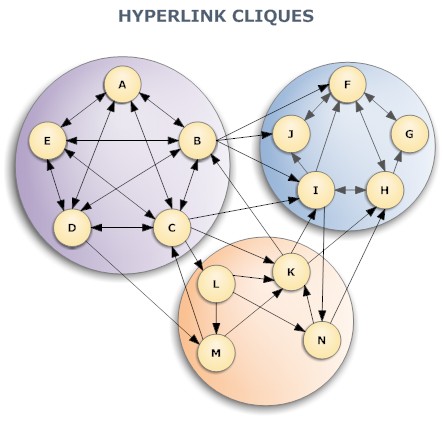Cliqueishness is part of normal human behavior – an extension of clannishness. Though when it comes to websites, you don’t expect that sort of thing, except maybe in a blog network. Why not? Well, isn’t the Internet about promoting global views? Being part of a clique of websites linking to each other could harm your SERPs rankings. (I’m not insisting this is true, but it could be – which is what I’m examining here.)
How do the SEs (Search Engines) know you’re part of a clique? Hypothesis: probably using graph theoretic methods, which are a sub-discipline of mathematics. Look at the “Hyperlink Cliques” graph diagram. Each node in the graph represents a website (or weblog). Each line segment represents a hyperlink, in the direction of the arrow, from any page on the source site to any page on the target site. A double arrow means there’s a reciprocal link, but not necessarily page to page. The terminology here, cliques and clusters, is mine.

Can you spot the link cliques? Why are the five sites A-E in the bigger circle part of a link clique? Why are the other two clusters not cliques?
Purple Cluster
Look at the purple cluster. Every site there has a link to every other site. This might signify a blog network, but only if the topics are sufficiently different. If they cover the same general topic, they’re a topical clique. This could be perceived as link collusion between the bloggers and could affect your rankings. (Suggestion: vary your blogroll.)
Blue Cluster
Is this a clique? No. Site F is the authority domain (relatively speaking) because all of the other sites, G-J, are pointing to it. But there isn’t a hyperlink between each and every pair of sites. There is, however, a short “path” between each pair. That is, through 1-4 clicks on hyperlinks, you could travel from any one site (F-J) to another in that cluster. For example, to get from F to I, you’d travel F-H-I, in that order.
Peach Cluster
Mmmm. Peach cluster. Ahhhhhh, tasty. Ahem. This cluster of sites isn’t a clique. In fact, it’s not even a cluster since you cannot travel from, for example, node M to N without going through K then I (which is part of Blue cluster). Thus, the linking between Peach sites is much more natural (excluding the social behavior of similar blogrolls) and likely “tastier” to spiders. Of course, this is only an example, and cliques do form naturally over time. So just because you’re a part of a topical clique isn’t necessarily a bad thing if it came about organically, over time. Reciprocal links just shouldn’t come too quickly.
Now, there are other clusters in the graph. Can you see them? Growing niches start with small cliques that expand, drawing in satellite cliques and clusters into their connectivity graph, but which are not part of the primary clique. This is normal linking behavior.
This is just an overview. I’ll be exploring the graph theory aspect of link building again in the near future, including having a look at different topographical types of blog networks.




